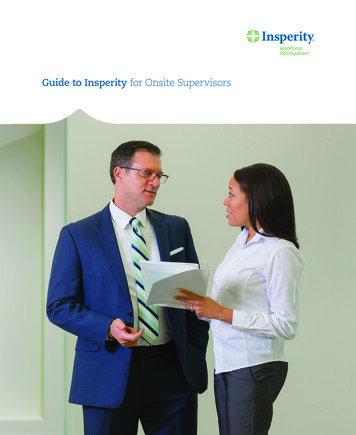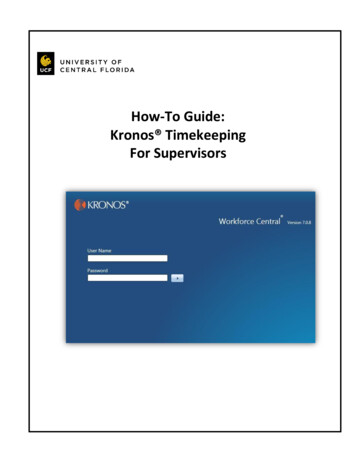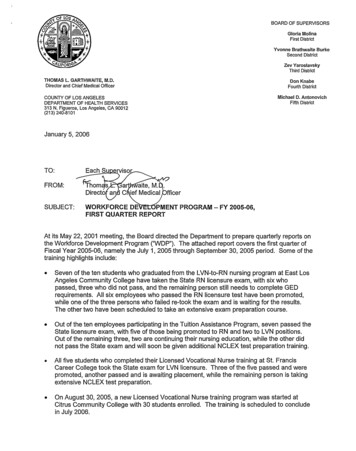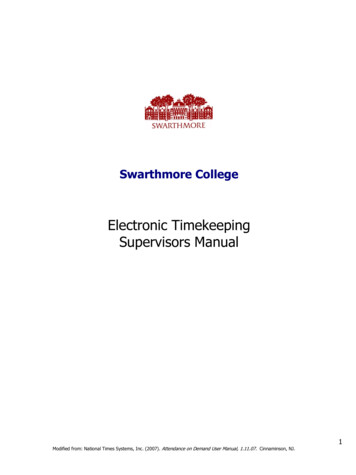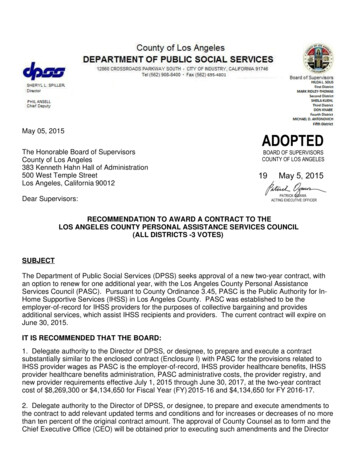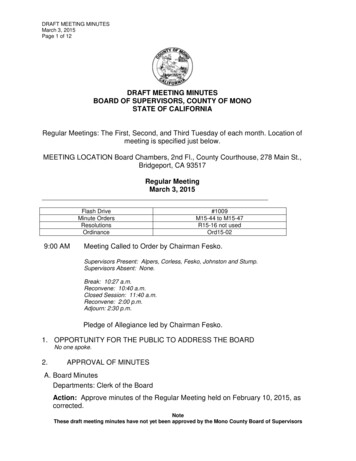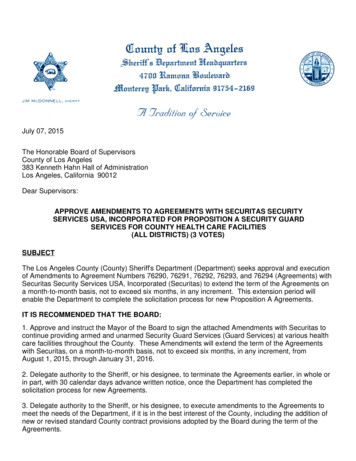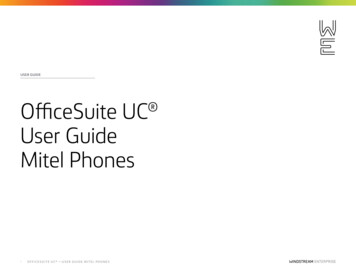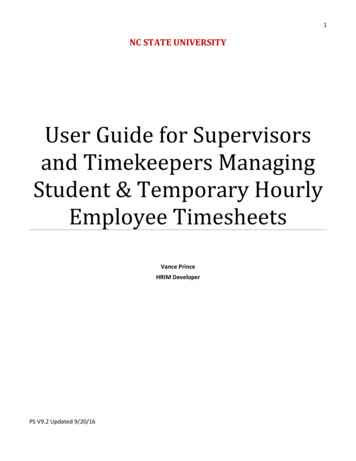
Transcription
1NC STATE UNIVERSITYUser Guide for Supervisorsand Timekeepers ManagingStudent & Temporary HourlyEmployee TimesheetsVance PrinceHRIM DeveloperPS V9.2 Updated 9/20/16
2ContentsIntroduction . 3Capturing Employee Punch Data . 4Timesheet Audits and Rounding . 4Supervisor Approval Mode . 5Supervisor Responsibilities . 6Timekeeper Responsibilities . 7Accessing Employee Timesheets . 8Time Exception Alarms . 9Exception Alarm Severity . 11High Exception Alarms . 11Low Exception Alarms . 11Viewing/Printing Biweekly Employee Processed Timesheets . 12Approving Reported Time. 13Capturing Employee Approval on the Timesheets . 13Timekeeper Manager Search Options . 14Time Management Summary . 15Supervisors/Managers . 15Timekeepers . 15Non-Exempt employees subject to the Fair Labor Standards Act (FLSA) are required to document thehours worked each day of the pay week. This user guide covers the fundamentals of reviewing,managing and approving temporary employee timesheets that utilize the KABA time collection system.PS V9.2 Updated 9/20/16
3IntroductionKABA is a third party automated time collection system integrated with the NC State University HR System.It is utilized to record the hours worked for all student workers and temp hourly employees. The universitysupports two types of Time Collection Devices (TCD).The KABA wall clock (TCD) has a built-in proximity ID reader whichallows the employee to simply scan their all campus ID card in front ofthe reader to clock in/out. (Follow the onscreen instructions)The KABA web clock (TCD) is accessible through MYPACKPortal/Employee Self-Service or through a web clock URL;http://go.ncsu.edu/timeclock. It allows employee to clock in/out bytyping in their 9 digit ID#, into the “Employee ID” field and clicking the“green OK” button. (Follow the onscreen instructions)Each college division on campus has dedicated Time Keeping Locations (TKL’s). When employees arehired into the HR system and utilize KABA they are assigned a TKL associated with the specificdept./division. To eliminate any confusion for the employee, the department supervisor or manager shouldexplain the KABA device options and indicate which TCD is preferred when clocking in/out for scheduledwork activity.Once the employee gets past the initial KABA login the display screenwill allow the employee to select the TKL name and number they areassigned to work in by clicking on the drop down arrow. This onlyapplies to employees with multiple jobs across campus. Employeeswith only one job will see just one TKL option. Please encourageemployees to be responsible and select the dept/TKL specified by theirdept. supervisor or manager.The KABA system will only allow the employee to clock in on one TKL at a time. In other words if theemployee clocks IN on the TKL displayed above (#704) the employee will have to clock OUT that TKL(#704) before they can attempt to clock in on another TKL.PS V9.2 Updated 9/20/16
4Capturing Employee Punch DataWhen the employee becomes active in the HR system, status updates are provided to the KABA TCDs. If awall clock TCD is the preferred method of recording punch data within the dept, the employee can scantheir badge ID in front of the proximity ID reader on the wall clock. Once the employee attempts to clockin/out, the KABA device validates the scanned proximity badge ID and/or 9 digit employee ID 9 (web clock).If the KABA device recognizes either ID it will allow the employee to clock in and record punch time. If theKABA device does not recognize the badge or employee ID, the person is typically not active and thescreen will indicate an “invalid” type message. If the employee receives an invalid message or the TKLdoes not match the information provided by the hiring dept the employee should notify their supervisorimmediately, who in turn will need to contact their College/Division Business Office for assistance.Recorded punch data is captured by a KABA TCDand automatically transferred directly into thePeopleSoft (PS) employee timesheet. Thetransfer of recorded punch data occurs every 15minutes starting at the top of the hour. Each INand OUT punch reflects a punch combination thatis calculated and processed during an audit cycle.Supervisors and/or timekeepers within the college division will be able to access the employee timesheet toreview, manage, update and approve. Daily timesheet review is recommended to resolve any questionablepunch data submitted by the employee. The employee’s direct supervisor will have to determine a routinethat allows them to resolve timesheet punch data issues in a timely manner.Deadlines for payroll processing are identified on the Payroll lockout schedule “Current Fiscal Year(Bi-weekly)” link. Any timesheet issues that are not resolved by payroll lockout deadlines will not becalculated and processed correctly for payment.Timesheet Audits and RoundingTimesheet audits occur four times a day: 4 AM, 11 AM, 2 PM and 7 PM, with the exception of Tuesdays at11 AM. The audits typically take up to 90 minutes to complete and during the audit employee punch data,timesheet adjustments and administrative entries are calculated.Rounding occurs during the audit cycle and based on each employee submitted IN and OUT punchcombination. The punch combination is rounded to the nearest quarter hour. If the punch combination is7.5 minutes or less during the quarter hour total time is rounded back. If the punch combination exceeds7.5 minutes during the quarter hour total time is rounded up.PS V9.2 Updated 9/20/16
5Supervisor Approval ModeWhen a college division is setup for approval mode the supervisor is responsible for reviewing andmanaging the employee timesheet, making any necessary adjustments or corrections before payrolllockout deadlines. Once the employee punch data is transferred to the timesheet an “Approve” box(highlighted below) will be available on each date the employee worked and must be checked directly onthe timesheet and submitted before payroll can process for payment. The following snapshot illustrates theemployee timesheet and the approval box. Also notice the “Reported Status” indicates “Needs Approval”.Once the approve box is checked and approved the system will automatically stamp the unity-ID of theadministrative personnel approving the timesheet data. The unity-ID of the person who approved thetimesheet will be displayed on the printable timesheet version for audit purposes. Approved timesheets canbe retrieved from the HR system for up to 24 months from the pay period date. Any timesheet retrievalbeyond 24 months will have to be retrieved through a query process initiated by the timekeeper. This modeof approval does not require a printed/signed timesheet because the approver unity-ID is permanentlystamped on the timesheet and can be retrieved from the HR system.However there may be scenarios when a printed timesheet will need to be generated for individuals paidfrom a grant account and the grant dept. requires a printed timesheet.PS V9.2 Updated 9/20/16
6Supervisor ResponsibilitiesEach student worker or temp hourly employee will have a direct supervisor identified on the hiringtransaction. This automatically allows the supervisor to access their timesheet and perform the following: Supervisor approval means all reported time on the employee timesheet has to be validated andapproved before the time is submitted for payroll processing. If a supervisor is unavailable to manage and/or approve employee timesheets for any reason theyshould notify the timekeeper within their division for assistance. Supervisors are responsible for making sure employee timesheets are accurate, valid and clear ofexception alarms for each scheduled pay period. (Reference the Exception Alarm section) Overtime is automatically calculated once 40 hours are exceeded during the pay period week,(Sat – Fri). Holiday pay is automatically calculated if punch data is recorded on a scheduled NCSU holiday date. Supervisors can update timesheets anytime during the pay period to resolve any punch data issues fortheir direct employees. Just have the employee submit a missed log punch report documenting themissed punch: 13/2016/02/miss-punchlog.pdf Supervisors can manage direct report timesheets during the specified pay period and have anadditional four days after the pay period which ends the following Tuesday at 5 PM. Any timesheetmanagement outside of the mentioned timeframe will have to be administered by the supporting dept.timekeeper. An email notification will be sent the following day after the pay period end date (Saturday) ONLY whendirect report timesheets have not been approved. A 2nd email notification will ONLY be sent the following Tuesday if any of your direct report timesheetshave still not been approved. This is the last opportunity (@ 5PM) for the supervisor to approve anytimesheet data.PS V9.2 Updated 9/20/16
7Timekeeper ResponsibilitiesEach college division has dedicated timekeepers’ set up to manage all or specific TKL’s within the division.The TKL assignments are established through a Security Access Request (SAR). Timekeepers will be ableto access employee timesheets and perform the following if the SAR has been approved: Timekeepers are responsible for making sure the supervisors are accurately validating employeetimesheets for the pay period. Timekeepers should also be the first point of contact for any issues the supervisor is unable to resolve. Employee timesheets can be retrieved by TKL#, dept/OUC#, employee name or empl-ID Supervisors should be managing and validating employee timesheets during the pay period.If timekeepers do not see progression being made on any exception alarm or missing punch dataintervene and contact the supervisor. If supervisors have not approved reported time during the pay period weeks, the timekeepers shouldintervene and contact the supervisor before the payroll lockout deadline to validate the timesheet.oEmployee timesheets cannot be processed for payment if they have not been approved.oIf a supervisor is unavailable to review and manage employee timesheets during the payperiod the timekeeper should intervene to review, resolve, validate and approve punch data.oIf the employee failed to clock in/out during the pay period have the person submit a missedlog punch report, documenting the missed punch data: 3/2016/02/miss-punchlog.pdf Overtime is automatically calculated once 40 hours are exceeded during the pay period week,(Sat – Fri). Holiday pay is automatically calculated if punch data is recorded on a scheduled NCSU holiday date. Payments will default to the distribution setup data established in the HR system.o If a specific portions of time needs to be paid from a different account, the project-ID can beentered at the far right side of the date the punch data was captured.PS V9.2 Updated 9/20/16
8Accessing Employee TimesheetsAccessing employee timesheets can be accomplished a couple of different ways, but the easiest way for asupervisor is through the “My Temporary Employees Time” quick link panel highlighted below. Simply clickon “My Temporary Employees Timesheets” to access the timesheet summary panel.Below is a snapshot of the Timesheet Summary panel.When a Supervisor selects “My Temporary Employees Timesheets” the timesheet summary panel willautomatically reflect a list of their direct reports.When a Timekeeper selects “My Temporary Employees Timesheets” the timesheet summary panel willautomatically reflect a list of employees based on the default manager search options covered later in thisdocument. Timekeepers can also specify search criteria as illustrated below. Remember to click “GetEmployees” once the criteria has been identified to retrieve the results.PS V9.2 Updated 9/20/16
9Time Exception AlarmsException alarms are generated directly on the timesheet when there is an issue with the punch datasequence submitted by the employee. To access and view exception alarms simply click on the “TimeExceptions” option located under the “My Temporary Employees Time” quick link panel highlighted below.The following exception panel will open after the link is selected.Exception alarms will appear directly on the timesheet in the form of an alarm clock icon,.To see a list of exception alarms for your direct reports and/or employees you manage simply click“Get Employees” highlighted above. If no names appear in the results then no exception alarms exist at thetime you initiated the request. Keep in mind that exception alarms can potentially span over long periods oftime if left unresolved and will continue to show up in the results until the exception is resolved.Unresolved exception alarms can cause the following issues: If the employee changes jobs the previous dept. no longer has access to the timesheet:o The new dept. timekeeper will have to work closely with the previous dept. timekeeper todetermine what caused the exception alarm and work together to resolve it.o Ultimately the dept. the employee worked in when the exception alarm occurred isresponsible for determining the resolution.The employee could potentially be over or under paid depending on the exception alarm severity.Unresolved exception alarms cause the timesheet audit cycle to take longer to process.PS V9.2 Updated 9/20/16
10In the following example the user clicked “Get Employees” to view any exception results.In the example above the system detected exception alarms for one employee but keep in mind the moreemployees you manage the larger the results could be. The last name of the employee is a hyperlink to theemployee timesheet. The following example reflects the panel opening to the date the exception alarmoccurred. The exception alarm icon will be displayed on the dates in question, illustrated below.In the example above the employee failed to clock out on 9/29 however there is also an alarm on 9/30. Thenext morning (9/30) the system had detected enough time between punches (18hrs) to reset the punchsequence to an IN punch. This type of alarm is considered a “back-to-back” IN punch alarm. When themissing OUT punch is entered for 9/29 click the “Submit” button. Once the audit picks up the out punchadjustment the timesheet will have to be approved again and the alarms will clear.PS V9.2 Updated 9/20/16
11Exception Alarm SeverityException alarm severity falls into two categories: High or Low. The following information examples thedifferences:High Exception Alarms High exceptions cannot be calculated and processed for paymentThe most common high exception is a scenario where the employee clocks in for work but fails toclock out at the end of scheduled work activityThe payroll process cannot determine the total time worked for the in/out punch combinationThe alarm will stay on the timesheet and the employee cannot be paid for the in/out punchcombination until it is resolved.The supervisor and/or timekeeper reviewing the exception can click on the employees namedisplayed in the results field to access the employee timesheet. The timesheet will open to thedate/pay period associated with the exception alarm.Review the timesheet to determine what caused the alarm, investigate any missing punch data andmake any necessary adjustments to resolve the alarm.Submit the timesheet adjustments and the alarm should clear after the next audit cycle if it hasbeen resolved.Low Exception Alarms Low exceptions can be calculated and processed for paymentThe most common low exception is a scenario where the employee has multiple jobs acrosscampus and clocks out of one job then immediately clocks in to a different job within 60 seconds.Another common low exception is a scenario where the employee has multiple jobs across campusand clocks in/out on the incorrect TKL or job.o The employee cannot correct their submitted punch data and this results in duplicatepunch data on two timesheets.o The employee will typically notify their supervisor on the correct job they should haveclocked in on, providing in/out punch times.o The supervisor or timekeeper manually updates the correct timesheet.o The dept. or supervisor with the submitted incorrect timesheet is often not aware of theissue unless notified.o This type of issue causes an over payment that will have to be recovered if not resolvedbefore the pay period lockout deadline.Reference the “Exception Alarm Trouble-Shooting Guide” for a list of exception alarms andrecommended resolutions: https://hrim.hr.ncsu.edu/kaba-resources/PS V9.2 Updated 9/20/16
12Viewing/Printing Biweekly Employee Processed TimesheetsViewing and/or printing employee timesheets provides the supervisor with an option to review timesheetsafter the punch data has been rounded to the nearest quarter hour each day the employee worked duringthe pay period. This version of the timesheet reflects any hours during the pay week that exceeds 40. Italso provides an option to review the project-IDs in which the hours worked will be paid. To review thetimesheet simply access the “My Temporary Employees Time” quick link and select “View/Print BiweeklyTimesheets.Supervisors will only have access to their direct reports timesheets so they only have to select the payperiod they would like to review.Timekeepers who manage and support TKLs within the division will have to navigate to the highlighted pathbelow and identify the “dept/OUC” or the “Time Group/TKL” along with the “Check Date” to generate andreview employee processed times
The KABA system will only allow the employee to clock in on one TKL at a time. In other words if the employee clocks IN on the TKL displayed above (#704) the employee will have to clock OUT that TKL (
